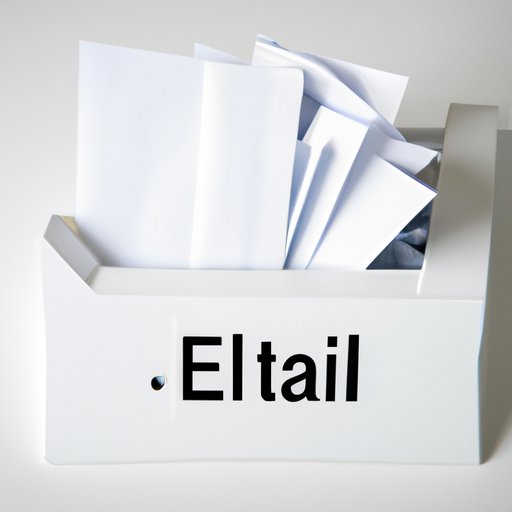
Introduction
Email inboxes can easily become cluttered, and this can have negative consequences for your productivity and organization. Deleting emails can be daunting, but it’s a necessary and surprisingly satisfying task. The purpose of this article is to provide step-by-step instructions for deleting emails, tips for organizing emails, common mistakes to avoid, and suggestions for archiving important emails.
Step-by-Step Guide to Deleting Emails
The first step to getting rid of unnecessary emails is to select them in bulk. You can select multiple emails at once by clicking on the “Select All” button. Alternatively, you can hold down the shift key while clicking on the first email, then clicking on the last email you want to delete.
Once you have selected your emails, you can choose to archive, delete, or move them to another folder. To delete them, click on the “Delete” button and they will be moved to the trash folder. However, these emails may still take up some space on your inbox, so make sure to delete your trash folder to delete them permanently.
It’s crucial to avoid accidental deletions, which can be disastrous if you delete important emails by mistake. To avoid such slips, back up or copy important emails before deleting. You can use cloud services such as Google Drive and Dropbox for this purpose.
Tips for Organizing Emails
It’s not enough to delete just any email, some you might need for reference later on. To keep your inbox organized and maintain a clean slate, you should create folders to store emails. Folders can be created for different topics such as work-related emails, travel emails, and social media emails. This helps to reduce clutter and makes finding any email faster and easier.
To ease sorting incoming email messages, use filters and rules. You can configure filters and rules to group similar email messages into a single folder, flag of high-priority messages from regular ones, or even block spam messages.
Another helpful tip is categorizing emails based on importance and urgency. You can use labels or markers to identify important emails that require immediate attention or those to be read later when you have more time.
Common Mistakes to Avoid
In practice, people often make some mistakes when cleaning their inboxes. For example, you may accidentally delete important emails, ignoring or underestimating the value of some emails. Sometimes, people even delete all their messages unintentionally.
It is important to avoid these mistakes—at all costs. Always double-check the emails before hitting the delete button. Review the spam and trash folders before permanently deleting any email. Another way is to seek the help of a colleague or friend before purging important emails. Never use shared or team accounts lightly.
Email Cleanup Challenges
Email cleanup can be a little dreary task considering the volume of emails we receive. You can gamify the whole experience of deletion and adding fun challenges to make it more enjoyable. Challenge yourself to delete a certain number of emails within a set timeframe and try to beat your previous record. The best way is to set rewards or incentives to those who complete the challenge to encourage motivation.
What to do with Old Emails
Old emails that have completed their purpose can either be deleted or archived for future reference. The best thing to do is to archive these emails by forwarding them to someone who may need to review them later. You can forward important information to different platforms or services. Also, there are a number of options available for back up of your emails—in your PC, phone, or cloud service.
Conclusion
In conclusion, deleting emails is necessary for keeping your inbox tidy, but it can be made less stressful and even enjoyable. As shown in this article, it is good to create folders, sort your emails, and use filters. Also, avoid common mistakes while cleaning your inbox and use gamification to add some fun element. Finally, don’t forget to back up crucial emails so that you can access them later. Putting these tips and strategies into practice will help you achieve a clean and well-organized inbox, thereby improving your productivity.





